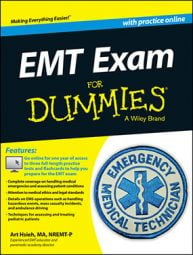Getting and maintaining an EMT certification
The requirements for becoming a certified emergency medical technician (EMT) vary from state to state. However, several steps are common to the EMT certification process. They include the following steps:
-
Enroll in an EMT course.
Search on the web or go to your local emergency medical services (EMS) or fire station to find out where reputable EMT training programs are offered. Talk to the program coordinator or main instructor to find out when the course meets, how long it lasts, what costs are involved, and other factors you want to know before deciding which one to enroll in.
-
Complete the EMT course.
EMT training programs are fairly intensive, taking at least 150 hours to complete. Review the course syllabus and understand what it takes to successfully complete the program.
-
Pass the NREMT or state exam.
Most states now use the National Registry of Emergency Medical Technicians (NREMT) exam as the qualifying test for state certification; your instructor will let you know whether another state exam is being used. You’ll want to prep a bit for either exam after you complete your EMT course.
-
Apply for state certification.
You complete an application and turn it in to the state EMS office, along with a fee. Some states require proof of successful course completion, and other states may require a criminal background check. You’ll want to check the state’s EMS website and talk to your instructor about the process.
-
Maintain your EMT certificate.
All states require you to attend continuing education classes in order to stay up-to-date on changes in practice. Several states require you to attend refresher courses each time you renew your EMT certificate, usually every two to three years. Your state’s EMS office likely has this information on its official website.
Elements of the EMT computer exam
The cognitive portion of the National Registry of Emergency Medical Technicians (NREMT) exam is a computer adaptive test (CAT) that continuously evaluates your performance as you answer each question. Here are a few things to keep in mind before you take the emergency medical technician (EMT) exam:
-
As you take the exam, the computer constantly evaluates how you respond to each question and shows you questions at a level of difficulty that matches your ability to answer them. In other words, the exam “pushes you” to see where your performance lies — above or below the minimum standard of difficulty. Therefore, the questions seem difficult, no matter whether you are doing well or poorly.
-
CAT asks you questions on a specific topic until it knows you are either above or below the standard. It then shifts to another section and repeats the process until all five sections are checked: Airway, Respiration, and Ventilation; Cardiology and Resuscitation; Medical and Obstetrics/Gynecology; Trauma; and EMS Operations. Because of this behavior, no two tests are ever alike. It may take as few as 70 questions or as many as 120 or more for the computer to calculate the statistical likelihood of your being above or below the standard.
-
After you finish the exam, your answers are scored by the computer and sent to the NREMT. After your results are reviewed and approved by NREMT staff, they are posted to your online account.
-
NREMT exams are delivered at Pearson VUE testing centers. These are offices that promote a secure, comfortable testing environment for many types of certification exams. You can schedule an exam at your convenience after your application is complete. Go to the NREMT website for more information.
Preparing to take the EMT exam
Don’t take the National Registry of Emergency Medical Technicians (NREMT) exam lightly. Prepare for the cognitive (computerized) portion of the emergency medical technician (EMT) exam by taking the following actions:
-
Create a study schedule and follow it.
-
Study in a place that promotes learning and retention.
-
Have all of your study materials at your side.
-
Use tools like flashcards and study with friends to enhance your studying.
-
Along with your knowledge, build your testing skills by taking practice tests. This in turn will build your confidence — another essential part of successful test-taking.
The practical portion of the EMT exam is the hands-on part. You’ll be tested on your ability to demonstrate various EMT skills, such as airway management, spinal immobilization, and splinting. The exam varies by state and is usually conducted at the end of the EMT course. Prepare for it by doing the following:
-
Practice, practice, practice. Skills like splinting and spinal immobilization require repetitious practice to become second nature.
-
Follow your skill sheets closely, especially when you’re first learning a new skill. You want to learn it right the first time rather than have to unlearn mistakes later on in the course.
-
Practice with classmates. You’ll need help with many of the skills. More importantly, other people can tell you what you’re doing right — or wrong — while you go through the steps.

